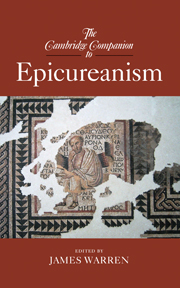Book contents
- Frontmatter
- Introduction
- 1 The Athenian Garden
- 2 Epicureanism in the Roman Republic
- 3 Epicureanism in the Roman Empire
- 4 Epicurean atomism
- 5 Epicurean empiricism
- 6 Cosmology and meteorology
- 7 Psychology
- 8 Action and responsibility
- 9 Pleasure and desire
- 10 Politics and society
- 11 Epicurean philosophy of language
- 12 Philosophia and technē: Epicureans on the arts
- 13 Removing fear
- 14 Epicurean therapeutic strategies
- 15 Epicureanism in early modern philosophy
- Bibliography
- Index
4 - Epicurean atomism
Published online by Cambridge University Press: 28 September 2009
- Frontmatter
- Introduction
- 1 The Athenian Garden
- 2 Epicureanism in the Roman Republic
- 3 Epicureanism in the Roman Empire
- 4 Epicurean atomism
- 5 Epicurean empiricism
- 6 Cosmology and meteorology
- 7 Psychology
- 8 Action and responsibility
- 9 Pleasure and desire
- 10 Politics and society
- 11 Epicurean philosophy of language
- 12 Philosophia and technē: Epicureans on the arts
- 13 Removing fear
- 14 Epicurean therapeutic strategies
- 15 Epicureanism in early modern philosophy
- Bibliography
- Index
Summary
Epicurean physics is fundamentally atomist. This means that it rests on two principal theses. The first is: 'All bodies are either indivisible small bodies or else are composed of indivisible small bodies.' The Greek adjective 'atomos' means 'indivisible, what cannot be divided'. When made into a noun, or when a noun is understood, usually it is translated as 'atom' or 'atoms'. Let us call this thesis the 'Atomist Thesis'. Epicurus sets it out in a canonical form at the beginning of his inquiry into physics at Letter to Herodotus 40: 'Amongst bodies, some are composites (sunkriseis); others are those from which the composites are made. These latter are indivisible (atoma) and unalterable ' Lucretius reprises the argument in the first book of the De rerum natura (DRN), calling the atoms 'principles' (principia) or 'the first elements of things' (primordia rerum). The 'composites' are rendered as concilia. It appears that Epicurus used this argument on various occasions, at least if we believe the scholion which accompanies this passage in the Letter to Herodotus: 'He also says this in the first book of On Nature and in books XIV and XV, as well as in the Great Epitome'.
- Type
- Chapter
- Information
- The Cambridge Companion to Epicureanism , pp. 65 - 83Publisher: Cambridge University PressPrint publication year: 2009
- 2
- Cited by



